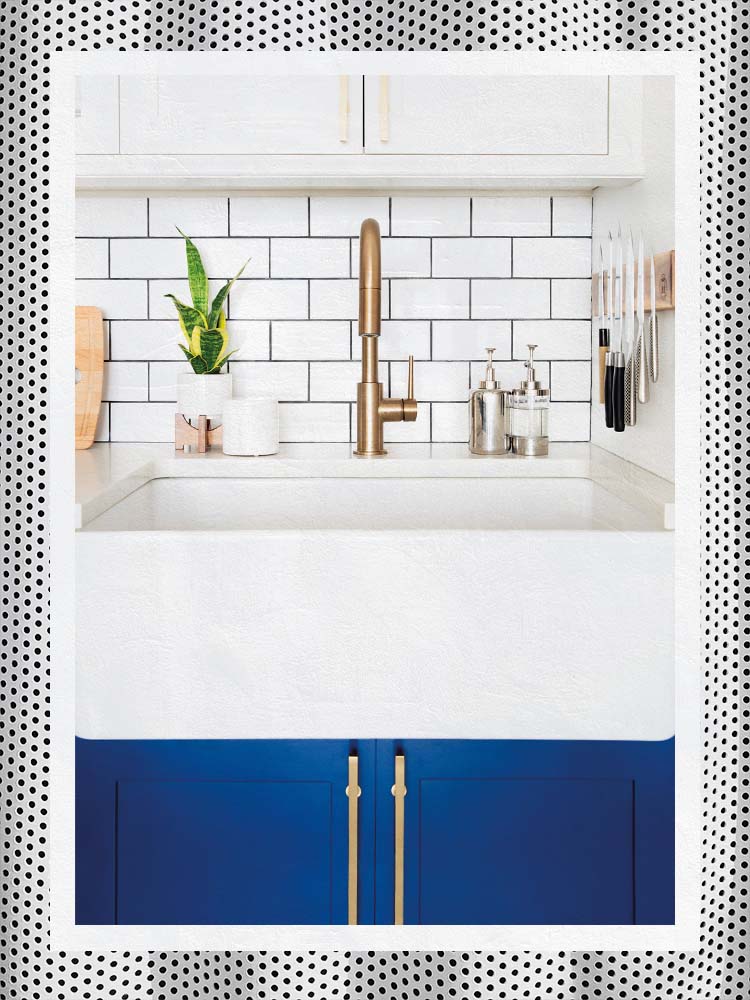Reading up on Domino’s shopping guides is like having your own personal product concierge. We do the tedious part—deep-dive research, hands-on testing, and tapping experts for advice—so all you have to do is hit ‘add to cart.’ That’s why we call them Simply the Best.
Skip the bulky pitchers and plastic bottles: The best under-sink water filters let you reclaim your counter (and fridge) space, and leave your sink space uncluttered. Instead of attaching a not-so-cute filter onto your fancy new faucet, you can keep this secret contraption—which removes chlorine, lead, rust, microplastics, and more—neatly tucked away. While the Environmental Protection Agency (EPA) regulates over 90 contaminants in public drinking water—-aka the tap that comes out of your sink without a filter—there are about 300 total contaminants that could be in your water, according to Christina Li, certified water sommelier at Wisewell.
The best way to remove these pollutants (goodbye, lead and chlorine) is through high-quality filtration, so we called on experts to weigh in on a roster of the best under sink water filters. Go forth and hydrate.
Our Favorites
- Best overall: Aquasana Claryum 3-Stage Max Flow
- Best value: iSpring Single-Stage Under Sink Water Filtration System
- Best all in one: GROHE Blue Professional Kitchen Faucet Starter Kit
- Best customizable: Hydroviv Under Sink Water Filter
- Best heavy duty filtration: Waterdrop Reverse Osmosis Water Filtration System
Best Overall: Aquasana Claryum 3-Stage Max Flow
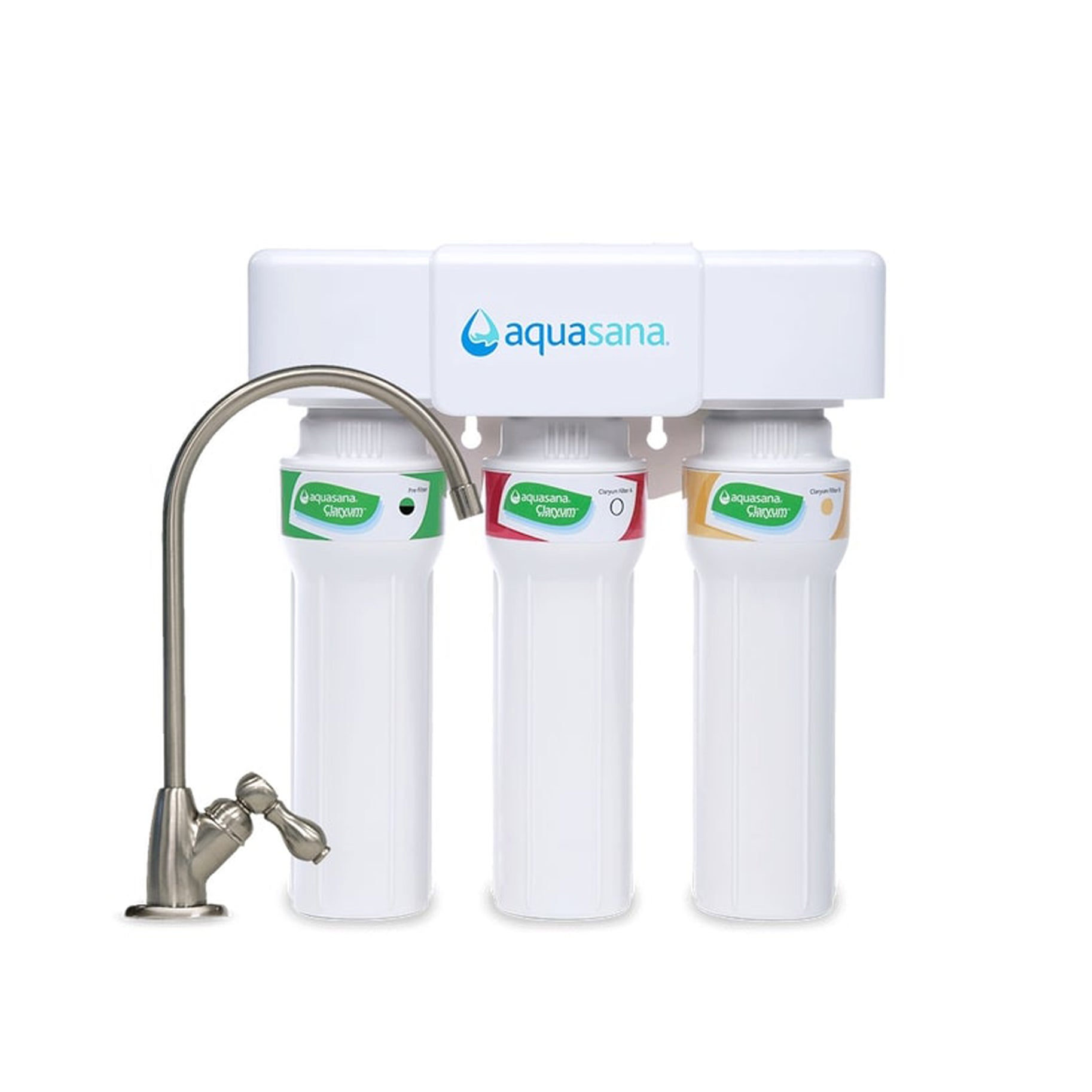
Flow rate: Gallon and half per minute | Filters out: 77 contaminants | Type: Charcoal
What we like:
- Fast flow rate
- Three stages of filtration
- Preserves minerals
Worth noting:
- May need professional installation
Why we chose it: With the fastest flow rate on this list, and one of the highest filtration on the market, this filter can make cleaner water quickly.
The Aquasana does not hold back. This system efficiently removes 77 contaminants (including lead, PFOA/PFOS, asbestos, pharmaceuticals, herbicides, and pesticides) while preserving beneficial minerals, thanks to its ingenious three-stage filter system that includes a pre-filter, activated carbon, and catalytic carbon with ion exchange. And if that wasn’t enough, it manages to do all of the above at rapid speed (it has the fastest flow rate on this list, purifying a half-gallon of water every minute), meaning you won’t notice much of a difference when filling up a pot of water for pasta.
Changing the filters is no fuss, and you’ll only have to swap out the carbon blocks every six months or so; easy peasy. This one is a bit more cumbersome, so it might be a good idea to keep your under-sink essentials (think: dishwasher pods and cleaner bottles) pared back.
Best Value: iSpring Single-Stage Under Sink Water Filtration System
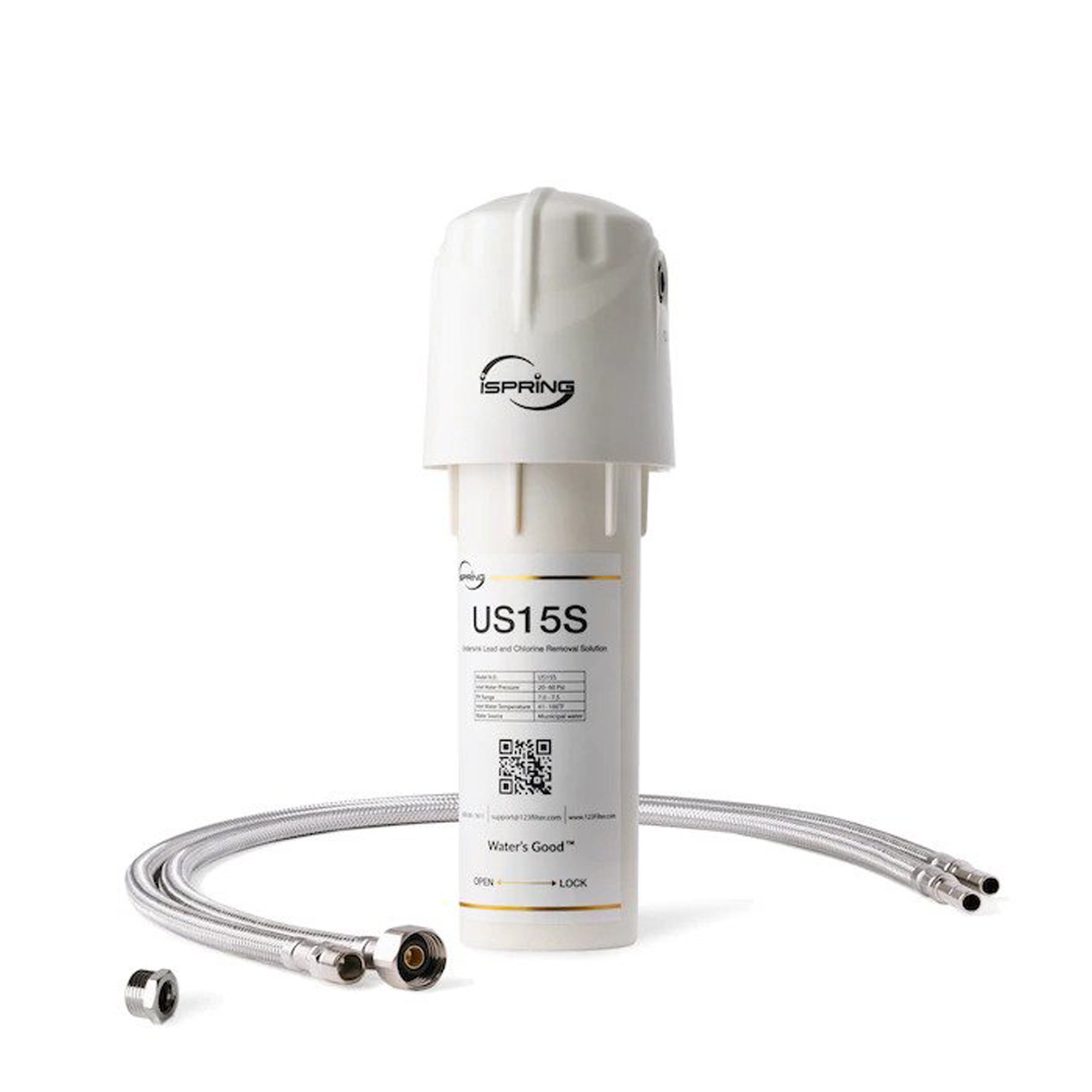
Flow rate: Gallon per minute | Filters out: 50+ contaminants | Type: Charcoal
What we like:
- Pretty much a breeze to install
- Portable and requires limited space
Worth noting:
- Only one stage of filtration
Why we chose it: Renters and homeowners alike will be happy they can install this affordable filter without tools.
You don’t need a big budget to get impressive filtration—this easy-to-set-up under sink filter proves it. iSpring’s small direct connect model can hook up straight to your cold water line in minutes (the average handy person will be able to tackle this themselves) and renters can take it with them to their next place. Inside, a charcoal filter is designed to remove up to 99 percent of chlorine, odor, bad taste, and heavy metals. And its small size means you can use the rest of your under the sink space for smart storage.
Best All In One: GROHE Blue Professional Kitchen Faucet Starter Kit
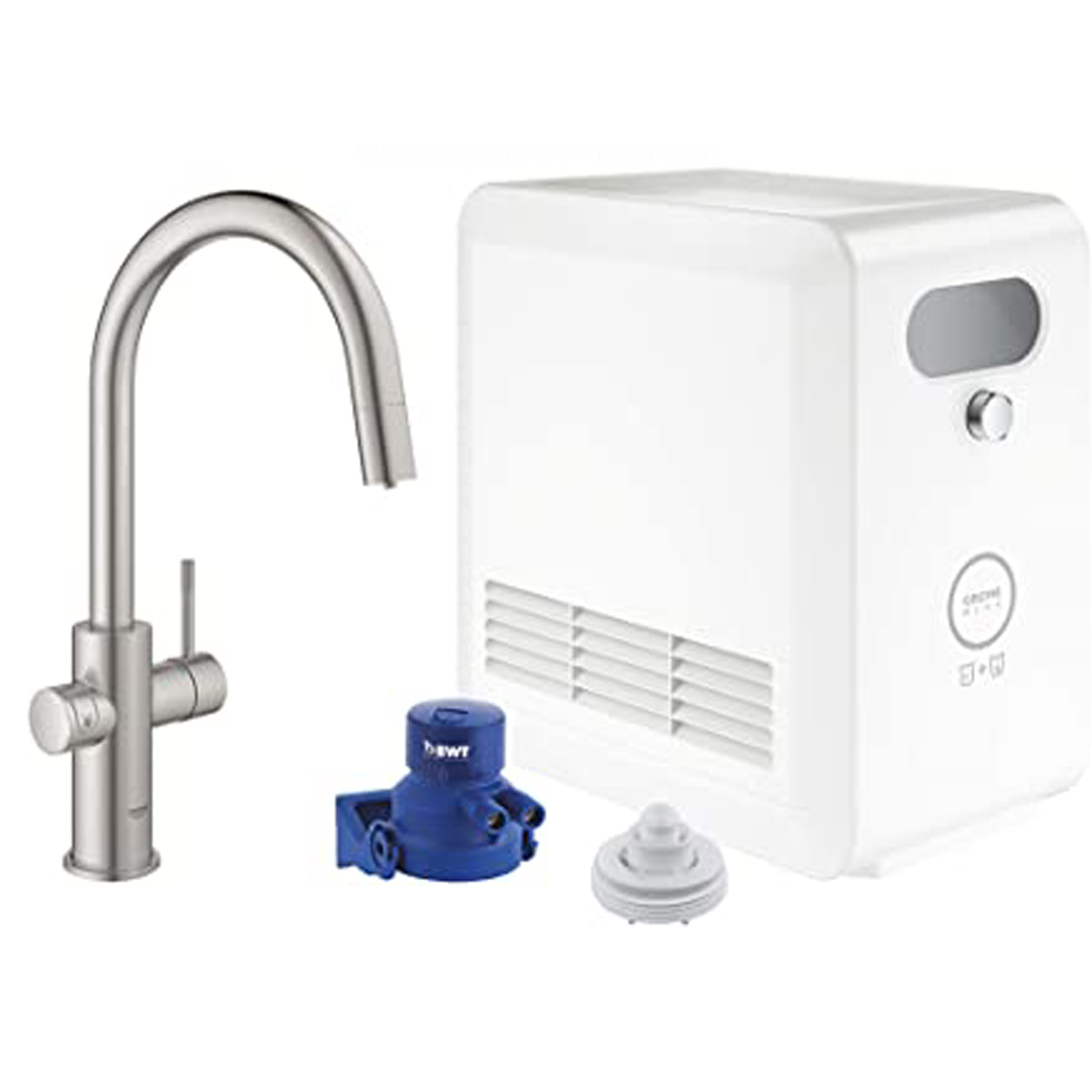
Flow rate: Gallon per minute | Filters out: Chlorine, limescale, heavy metals, and particles | Type: Charcoal
What we like:
- Has an app to troubleshoot and track water usage
- Efficient flow rate
- Five filtration stages
Worth noting:
- Pricy
Why we chose it: Filtration, plus chilled and sparkling water, all in one pretty package.
If you take your hydration seriously (a glass always in hand), consider shelling out a bit more for a filter that can transform your water in more ways than most. While all under sink filters offer cleaner water, this Grohe model goes above and beyond with the option for it to dispense chilled or sparkling water, too. Seriously, you may wonder why you’ve been sipping normal tap water for so long. It uses an impressive five stages of filtration, including a pre-filter, activated carbon pre-filter, ion exchanger, activated carbon filter, and fine filter to remove a wide variety of odors, contaminants, and particles in your water.
And if you’re the forgetful type when it comes to filter changes, there’s an app for that. The Grohe app lets you know exactly when to change the filter and CO2 capacity, so you’ll never be without fresh water. You can also use it to monitor how much water your family is actually drinking, says Robert Scott, Leader, Product Planning & Strategy, Fittings at LIXIL Americas.
Best Customizable: Hydroviv Under Sink Water Filter
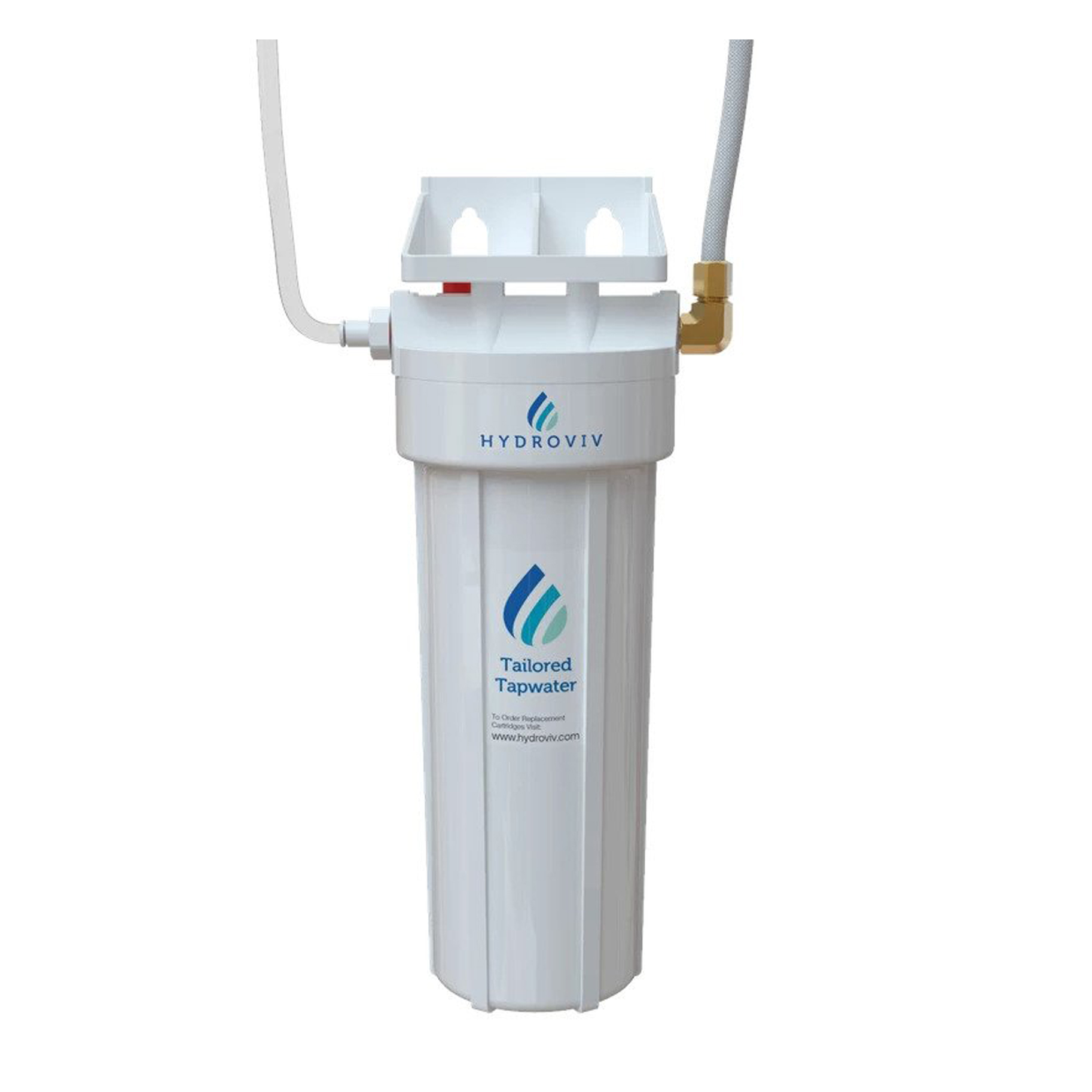
Flow rate: Gallon per minute | Filters out: Most, but dependent on area | Type: Charcoal
What we like:
- Uses your zip code to personalize filtering
- Easy to install
- Filters autoship to your door
Worth noting:
- A bit expensive
- Single stage filtration
Why we chose it: This Shark Tank favorite factors in location to know what contaminants to focus on.
Like a personal water expert at your fingertips, this under sink filter dials in your zip code to tailor containment removal needs based on the watershed in your area. Hydroviv claims that it removes common chemicals, volatile organic compounds (VOCs), and more. We also love that you can opt for autoship of new filters, which will serve as a gentle reminder that it’s time to swap out your current one for a refresh.Plus, this direct-connect under sink filter is simple enough for the average homeowner to install quickly; you simply hook it up to your water line—no drilling required.
Best for Heavy Duty Filtration: Waterdrop Reverse Osmosis Water Filtration System
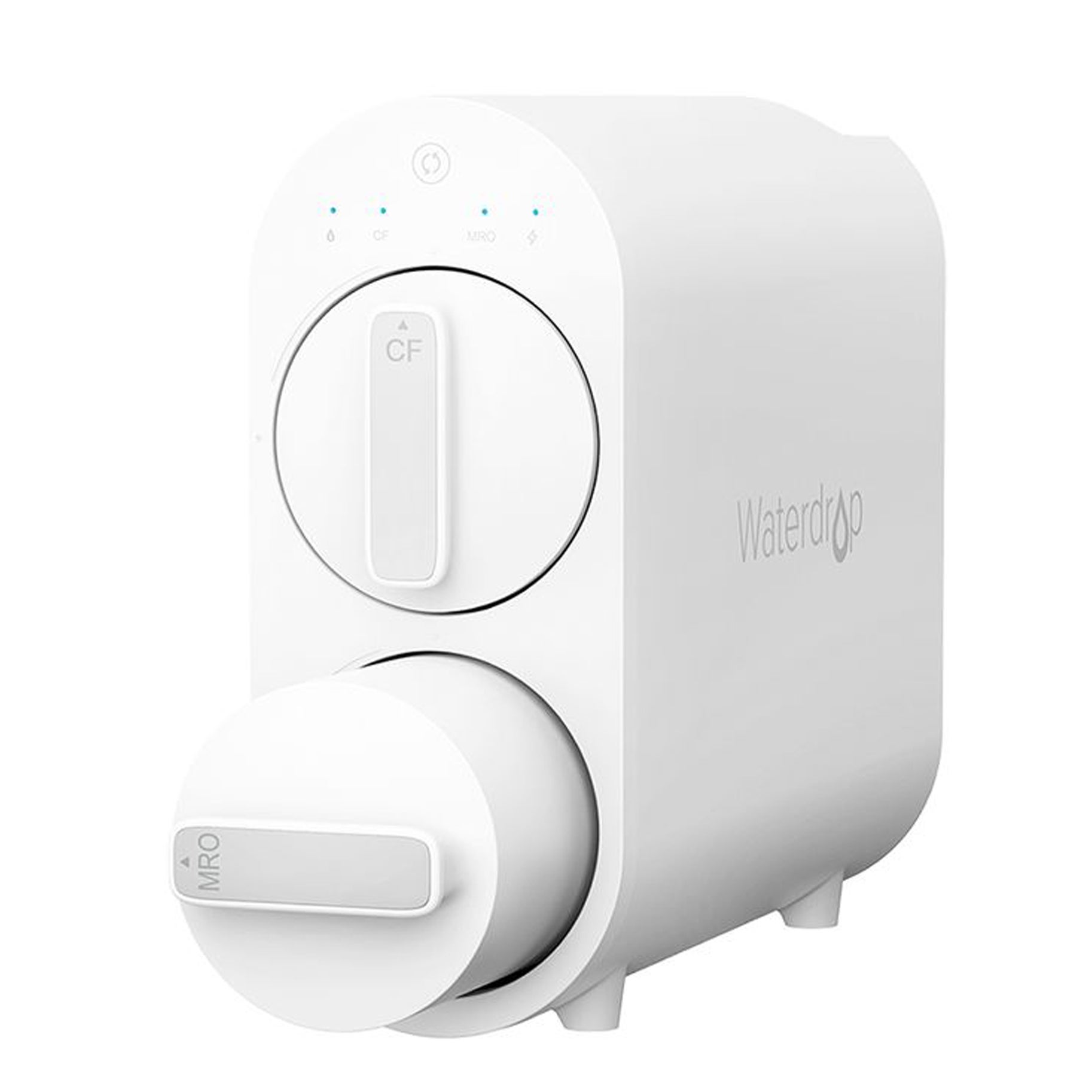
Flow rate: Gallon per minute | Filters out: 99+ contaminants | Type: Reverse osmosis
What we like:
- Removes tricky containiments
- Tankless design
- Saves water compared to other RO modes
Worth noting:
- Expensive
Why we chose it: This tankless filter can remove even some of the most roguish contaminants without taking up too much space under your sink.
If you live in an area with a lot of known pollutants, a reverse osmosis (RO) system may be your best bet. “For maximum contaminant reduction, reverse osmosis systems provide the most comprehensive protection and tackle even the more difficult substances,” Derek Mellencamp, general manager at Aquasana, says. This one from Waterdrop has a tankless design that expels only one cup of waste water per two cups of filtered water, which is 600% more efficient than your traditional RO filter. It is also National Sanitation Foundation (NSF) 58 certified, which means it can tackle everything from heavy metals to pharmaceuticals and you can sip worry free. The machine itself also gives you some important information, like a light indicator on the faucet, for when it’s time to swap the filter, and the smart monitoring panel, which tells you the quantity of total dissolved solids being removed.
How We Chose These Products
Clean water is essential to good health. While no filter can remove everything, we selected products that live up to NSF standards for filtration and are loved for how they make water taste. We also tapped water experts and a water sommelier to help guide product picks, as well as inform us about the various filtration types. From there, we narrowed our search to evaluate top-rated models based on filtration, how easy they are to install, and any special features.
Our Shopping Checklist
Filter Life
While the longevity of your filter depends on how much you use it, most only need to be replaced every six months, on average. But unless your filter comes with an app or indicator of when to replace it, you can’t be exactly certain on timing, which is why that timeframe is recommended for most. If you have a big family or if your house is a revolving door to guests, you may want to clear out the filter even more regularly. Luckily, the process is relatively simple, and all you’ll need to do is swap out the cartridge for a new one. “The most important thing you can do is replace your filter regularly, because the medium does get consumed the more you use it,” Mellencamp says.
Type
There are two main types of under the sink filters: carbon and RO. According to Mellencamp, the most effective filters incorporate both. You’ll also find multiple stages of filtration, which allows for fine-tuned removal of particles, chemicals, and odors.
Carbon: This is the most traditional filter, but is still effective and is used in multiple stages of filtration. It works by using activated carbon that will chemically bond with contaminants, removing them as water flows through the filter. These filters are typically smaller and easy to install.
RO: Reverse osmosis is essentially a process where water pressure forces tap water through a membrane, only allowing teeny-tiny water molecules through and rejecting chemicals that are any larger. It will remove dissolved solids, toxins, chlorine, fluoride, and heavy metals, as well as bacteria and pesticides. However, it does create some waste water through this process, which typically goes back down your drain; this makes the install a bit more complex.
Installation
Unlike a water pitcher filter or faucet filter, installing an under sink filter may require you to roll up your sleeves for a bit of handy work. “With under the sink, the level of complexity of the install can scare some people away,” Mellencamp says. For those more complicated systems, such as an RO filter, Scott, recommends hiring a professional to ensure you’re set up properly.
But plenty of other models can be easily added by the average homeowner. According to Mellencamp, the easiest to install are direct connect filters, which involve simply unscrewing your cold water line and attaching the filter to it, so it will work with your current faucet.
Effectiveness and Certifications
The effectiveness of the filter often depends on the stages of filtration, as well as the tap water in your area. But, according to Li, before purchasing a filter, it’s a good idea to check if it has been approved by the NSF and the Water Quality Association (WQA). Some of the key certifications include NSF/ANSI 42, which mean a filter has been approved to
to reduce the amount of chlorine and odor for better tasting water. For RO systems, look for NSF/ANSI 58, which says the filter has been proven to reduce contaminants that are regulated by the EPA.
Contaminants and Odor Removal
“People think that their Brita filter is going to remove lead, but those gravity systems aren’t powerful enough,” Mellencamp says. “The higher number of contaminants you can remove from your water the better.”
According to Li, there could be up to 300 contaminants in our water at any given time. But the most common contaminants to be aware of are chlorine (typically used in water treatment centers) lead, rust, microplastics, PFOA/PFOS, pharmaceuticals, bacteria, and more. Depending on where you live, levels may be higher.
Under the sink filter that are NSF-certified will remove these common contaminants that water treatment centers alone can’t filter out, or add chemicals into the water through its cleaning processes. “We drink water everyday, if you don’t have a filter you’re going to consume a small amount of these over time,” she says.
Flow Rate
Under the sink water filters tend to have a faster flow rate compared to your standard faucet filter, meaning you won’t be waiting over a minute to fill up your cup. Because of the filtering process, though, it will be slightly slower; anything over a gallon per minute should be fine for the average home.
“You want a flow rate of a gallon per minute or you’re going to notice a difference and people don’t like it,” Mellencamp says. “In order to flow at that [effective] rate, it’s going to need to be big to be effective. “
Ask Domino
Q: Can I install an under sink water filter by myself?
Yes, depending on the model. An experienced handy person could likely install a complex RO system on their own, but a more novice installer might only be qualified to link a direct connect system into their cold water line. When in doubt, hire a professional.
Q: How long do under sink water filters last anyways?
According to Mellencamp, an under sink system should last indefinitely, as long as you change the filter cartridges regularly. Those are typically the first parts to wear out.
Q: Can under sink filters remove all contaminants and impurities?
While no filter can catch everything, most quality filters can remove up to 99 of the most concerning contaminants people find in their tap water. This includes lead, microplastics, chlorine, VOCs, and pharmaceuticals, among other potentially unsafe stuff lurking in our water.
The Last Word
Under the sink filters can be a peace-of-mind addition to any home, and lead to sipping on better-tasting water right from your tap that’s mostly free of impurities and pollutants. For most, the Aquasana Claryum 3-Stage Max Flow will provide some of the highest filtration and fastest flow rates. However, if you want something a little more luxe that includes a sparkling water option, the Grohe Blue Professional Kitchen Faucet Starter Kit is worth the splurge.
Domino’s editors independently curate every product on our site, because we’re just as obsessed with a great deal and an under-the-radar discovery as you are. Items you purchase may earn us an affiliate commission.
The post Drink Straight from the Tap with the Best Under Sink Water Filters appeared first on domino.

